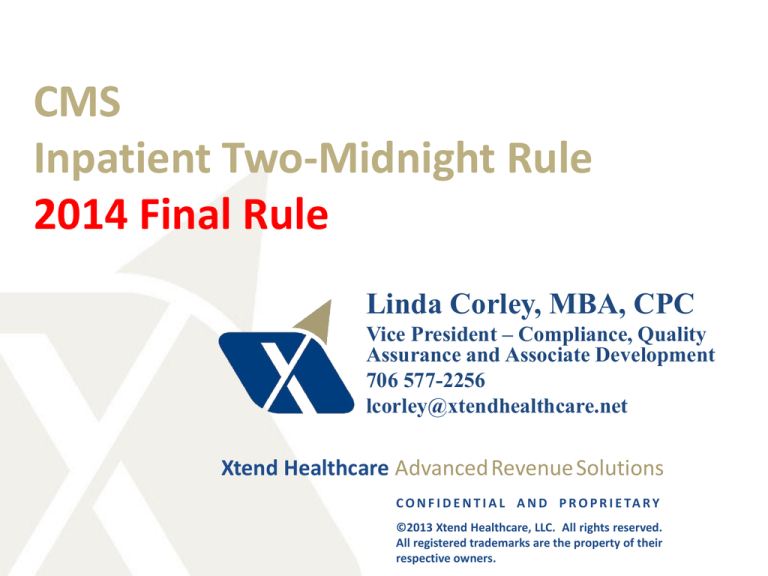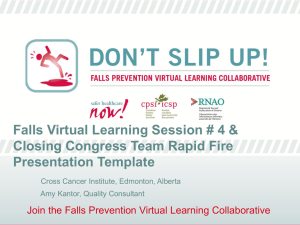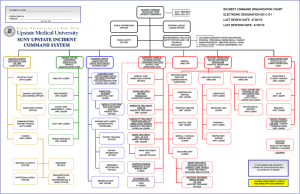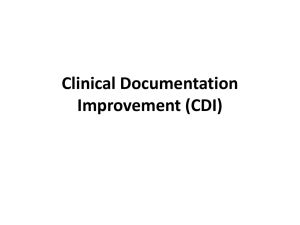
CMS
Inpatient Two-Midnight Rule
2014 Final Rule
Linda Corley, MBA, CPC
Vice President – Compliance, Quality
Assurance and Associate Development
706 577-2256
lcorley@xtendhealthcare.net
Xtend Healthcare Advanced Revenue Solutions
C O N F I D E N T I A L A N D P R O P R I E TA R Y
©2013 Xtend Healthcare, LLC. All rights reserved.
All registered trademarks are the property of their
respective owners.
Agenda
• Reimbursement “environment” strategy!
• Importance of Two-Midnight Rule
– What’s happening with Medicare inpatient payments?
– What is the new inpatient admission “benchmark” for
medical necessity?
– Why all this focus on Case Management / Utilization
Review to ensure “revenue integrity”?
– Finalizing Proposed CMS Rules1455 and 1599
• Impact on hospital Revenue Cycle collaboration
• Preparation and actions to consider for effective
reimbursement
Proprietary and Confidential. © 2013 Xtend Healthcare, LLC. All rights reserved. All registered trademarks are the property of their respective owners
2
Overview of IPPS Final Rule
• Published August 19, 2013 (released August 2nd)
• Effective: October 1, 2013 (Q1 CMS fiscal year)
• 546 total pages in Federal Register, August 2nd
publication release was 2,255 pages
• Most of the language from the proposed rules
remained unchanged
• Key pages Federal Register: 50506-50954
• Document includes updates on a wide range of topics
– today’s focus will be on Two Midnight Rule and its
affect on inpatient reimbursement
Proprietary and Confidential. © 2013 Xtend Healthcare, LLC. All rights reserved. All registered trademarks are the property of their respective owners
3
2014 Inpatient Prospective Payment System
•Let’s take a short quiz on the state of YOUR current
Medicare Reimbursement practices before we begin our
discussion!
Proprietary and Confidential. © 2013 Xtend Healthcare, LLC. All rights reserved. All registered trademarks are the property of their respective owners
4
2014 Inpatient Prospective Payment System
Reimbursement operations practices:
1. What four (4) initiatives may be lowering your Medicare
payments for 2014?
2. Can your Revenue Cycle team produce a positive affect
on all four of these?
3. What long-term reimbursement methodologies should
your facility address every month?
4. Rate your “patient care management” program (CM,
UR, DC Planning) on a 1 (poor) to 5 (excellent) scale.
5. What $$ amount was written-off at your facility last
month (and YTD) due to services provided in the “wrong
setting,” “not medically necessary,” or “short-stay denied
when billed as inpatient care”?
Proprietary and Confidential. © 2013 Xtend Healthcare, LLC. All rights reserved. All registered trademarks are the property of their respective owners
5
2014 Inpatient Prospective Payment System
Reimbursement operations practices:
1. What four (4) Medicare initiatives may be lowering your
payments for 2014?
Re-admissions
Quality Reporting
RAC / Revenue Integrity Audit Reviews (MAC, OIG)
Two Midnight Rule
2. Can your hospital Revenue Cycle team produce a positive
affect on all four of these?
3. What long-term reimbursement methodologies should
your facility address every month?
MS-DRGs – CMI and LOS
ICD-10 effect on patient population / top procedures
“Present on Admission” indicators / documentation
Proprietary and Confidential. © 2013 Xtend Healthcare, LLC. All rights reserved. All registered trademarks are the property of their respective owners
6
2014 Inpatient Prospective Payment System
Reimbursement operations practices:
4. Rate your “patient care management” (CM, UR, DC
Planning) program on a 1 (poor) to 5 (excellent) scale.
Time for honest and in-depth evaluation of the
“results” of these staff members!
Noted as the “only” identified Revenue Cycle
Department whose performance either substantially
increases or decreases CASH!
5. What $$ amount was written-off at your facility last
month (and YTD) due to services provided in the “wrong
setting,” “not medically necessary,” or “short-stay denied
when billed as inpatient care”?
Track, Set improvement goals, communicate, reward!
Proprietary and Confidential. © 2013 Xtend Healthcare, LLC. All rights reserved. All registered trademarks are the property of their respective owners
7
Pay for Performance Dichotomy
Problematic challenge:
• Past challenge for hospitals has been dichotomy of clinical “care
plans” and/or “protocols” for patient care, versus Medicare
“coverage, coding and billing” requirements.
• The two are not the same – but they do overlap!
– The overlap is where “pay-for-performance” and value-based
purchasing of medical services will be resolved.
• The two requirements must be merged!
• Each hospital / facility location is different –
– Must perform “risk” analysis to identify specific strengths and
weaknesses for collaboration of clinical and revenue cycle staff
members.
• Financial results such as denials, medical necessity write-offs,
bundling of services, re-admission data, and quality benchmarks
must be shared.
Proprietary and Confidential. © 2013 Xtend Healthcare, LLC. All rights reserved. All registered trademarks are the property of their respective owners
8
2014 Inpatient Prospective Payment System
Admission and Medical Review Criteria for Inpatient Services
•The final rule modifies and clarifies CMS’s longstanding
policy on how Medicare contractors review inpatient hospital
admissions for payment purposes.
•A beneficiary is considered an inpatient of an acute care
hospital and a CAH if formally admitted as an inpatient
pursuant to an order for inpatient admission by a physician.
•The order must be furnished by a qualified and licensed
practitioner who has admitting privileges at the hospital, who is
knowledgeable about the patient’s hospital course, medical
plan of care, and current condition.
Proprietary and Confidential. © 2013 Xtend Healthcare, LLC. All rights reserved. All registered trademarks are the property of their respective owners
9
2-Midnight Inpatient Benchmark
• … We (CMS) provided hospital inpatient admission guidance
specifying that a physician, or other qualified practitioner
(herein we will refer to the physician, with the understanding
that this can also pertain to another qualified practitioner)
• should order inpatient admission if he or she expects that the
beneficiary’s length of stay will exceed a 2-midnight
benchmark or if the beneficiary requires a procedure
specified as “inpatient-only” under § 419.22.
Page 50944, IPPS Rule
Proprietary and Confidential. © 2013 Xtend Healthcare, LLC. All rights reserved. All registered trademarks are the property of their respective owners
10
2-Midnight Benchmark (con’t)
• Our (CMS) proposed 2-midnight benchmark, which we now
finalize, simply modifies our previous guidance to specify that
the relevant 24 hours are those encompassed by 2 midnights.
Page 50945, IPPS Rule
• The benchmark used in determining the expectation of a stay
of at least 2-midnights begins when the beneficiary starts
receiving services in the hospital.
• We (CMS) do not believe beneficiaries treated in an intensive
care unit should be an exception to this standard, as our 2midnight benchmark policy is not contingent on the level of
care required, or the placement of the beneficiary within the
hospital.
Page 50946, IPPS Rule
Proprietary and Confidential. © 2013 Xtend Healthcare, LLC. All rights reserved. All registered trademarks are the property of their respective owners
11
Benchmark vs. Presumption
• “Benchmark of 2 midnights”
– The decision to admit the beneficiary should be based on
the cumulative time spent at the hospital beginning with
the initial outpatient service.
– In other words, if the physician makes the decision to
admit after the beneficiary arrived at the hospital and
began receiving services, he or she should consider the
time already spent receiving those services in estimating
the beneficiary’s total expected length of stay.
Page 50946, IPPS Rule
The time a beneficiary spends as an outpatient before the formal
Inpatient admission does not count as Inpatient time, but may be
considered by the physician when determining if the expectation
of a stay lasting at least 2-midnights in the hospital is reasonable
and generally appropriate for inpatient admission.
Proprietary and Confidential. © 2013 Xtend Healthcare, LLC. All rights reserved. All registered trademarks are the property of their respective owners
12
2-Midnight Benchmark
Important Note!
• CMS has responded to a question regarding when a patient is
admitted for Observation for one day, and on the second or
even third day, the patient’s condition deteriorates; and then
the patient is admitted as an Inpatient who is discharged one
day after admission. The RACs previously would review this
as a 1-day stay – even though the patient was actually in the
hospital for three days. How would this scenario be reviewed
under the new 2-Midnight Rule?
• … Per CMS, as soon as the physician believes that a second
day of Observation will be needed, an Inpatient order should
be written!
• One CMS rep stated: “Under this application of the 2Midnight Rule, there should be no Observation stays of more
than 1 day!
Proprietary and Confidential. © 2013 Xtend Healthcare, LLC. All rights reserved. All registered trademarks are the property of their respective owners
13
2-Midnight Benchmark
• What about InterQual or Milliman “medical necessity” criteria
for Inpatient admission?
• … Per CMS, the 2-Midnight Rule will apply even if an
admission failed InterQual or Milliman …
The only (medical review) question will be
…whether there was a medical reason that required the patient
to be in the hospital for at least 2 midnights
…even if that reason is that the patient must remain under
Observation for at least 2 days.
• One CMS rep stated: “Under this application of the 2Midnight Rule, there should be no Observation stays of more
than 1 day!”
Proprietary and Confidential. © 2013 Xtend Healthcare, LLC. All rights reserved. All registered trademarks are the property of their respective owners
14
Benchmark vs. Presumption
• “Presumption of 2 midnights”
– Under the 2-midnight presumption, inpatient hospital
claims with lengths of stay greater than 2 midnights, after
formal admission following the order, will be “presumed”
generally appropriate for Part A payment, and
– will not be the focus of medical review efforts absent
evidence of systematic gaming, abuse or delays in the
provision of care…
Page 50949, IPPS
Proprietary and Confidential. © 2013 Xtend Healthcare, LLC. All rights reserved. All registered trademarks are the property of their respective owners
15
Physician Order
• For payment of hospital inpatient services under
Medicare Part A, the order must specify the admitting
practitioner’s recommendation to admit “to inpatient,”
“as an inpatient,” “for inpatient services,” or similar
language specifying his or her recommendation for
inpatient care
Page 50942, IPPS
• “Admit to Med/Surg” or
“Admit to Dr. Smith”
are no longer acceptable
• No longer acceptable “inferred”
Inpatient admission order
• Verbal order must be properly
countersigned by the physician who gave the verbal order!
Proprietary and Confidential. © 2013 Xtend Healthcare, LLC. All rights reserved. All registered trademarks are the property of their respective owners
16
Physician Certification
• …while the physician order and the physician certification
are required for all inpatient hospital admissions in order for
payment to be made under Part A,
• the physician order and the physician certification are not
considered by CMS to be conclusive evidence that an
inpatient hospital admission or service was medically
necessary.
– The decision to admit is a complex medical judgment, and the 2Midnight instruction does not override the clinical judgment of the
physician …
– Admission reviews will continue to play an important role in ensuring
hospitals are compliant with CMS guidelines.
• Rather, the physician order and physician certification are
considered along with other documentation in the medical
record.
Page 50940, IPPS
Proprietary and Confidential. © 2013 Xtend Healthcare, LLC. All rights reserved. All registered trademarks are the property of their respective owners
17
Order and Certification
• “(c) The physician order also constitutes a required
component of physician certification of the medical necessity
of hospital inpatient services under subpart B of Part 424 of
this chapter.
• (d) The physician order must be furnished at or before the
time of the inpatient admission.”
Page 50965, IPPS
Proprietary and Confidential. © 2013 Xtend Healthcare, LLC. All rights reserved. All registered trademarks are the property of their respective owners
18
Order and Certification
What are the components of a valid Certification for
Inpatient admission?
•
•
•
•
Physician order for inpatient admission
Medical reason for Inpatient hospital stay – Primary Diagnosis
The expected time the patient will remain in the hospital
Plan for inpatient care (services), any diagnostic test orders
and findings, and progress notes
• Plan for post-hospital care
– See new requirements for “discharge planning” documentation
• Physician Certification must be documented and signed in the
medical record prior to patient discharge!
42 CFR SS 424
Proprietary and Confidential. © 2013 Xtend Healthcare, LLC. All rights reserved. All registered trademarks are the property of their respective owners
19
2-Midnight Rule
What is your facility’s PLAN?
• Written procedures for
–
–
–
–
Case Managers
Physicians
Patient Access (Registration) Reps
PFS Medicare Billers
• Consider CM – Physician “team” for inpatient documentation!
• Consider pre-bill edit to hold Medicare inpatient claims that
are one-day stays.
• Case Manager or Nurse Auditor Review prior to billing
• Take specific deficiencies in documentation and LOS back to
physician for review (ideally, back to CM – Phys team)
Proprietary and Confidential. © 2013 Xtend Healthcare, LLC. All rights reserved. All registered trademarks are the property of their respective owners
20
No substitute for UM Process
• “Use of Condition Code 44 or Part B inpatient billing pursuant
to hospital self-audit is not intended to serve as a substitute
for adequate staffing of utilization management personnel or
for continued education of physicians and hospital staff
about each hospital’s existing policies and admission
protocols.”
Page 50914, IPPS
Proprietary and Confidential. © 2013 Xtend Healthcare, LLC. All rights reserved. All registered trademarks are the property of their respective owners
21
Beneficiary Impact
• “Beneficiaries who are treated for extended periods of time
as hospital outpatients receiving Observation services may
incur greater financial liability than they would if they
were admitted as hospital inpatients.
• They may incur financial liability for Medicare
– Part B copayments,
– the cost of self-administered drugs that are not covered
under Part B, and
– the cost of post-hospital SNF care because section
1861(i) of the Act requires a prior 3-day hospital
inpatient stay for coverage of post-hospital SNF care
under Medicare Part A.”
Page 50907, IPPS
Proprietary and Confidential. © 2013 Xtend Healthcare, LLC. All rights reserved. All registered trademarks are the property of their respective owners
22
Additional Guidance
• Expect “sub-regulatory guidance” (i.e., more detailed
information) in these areas:
– “Objective medical information”
– Transfers and impact on 2 midnights
– Refunding the part A deductible to the
patient if rebilling for part B
– Verbal orders for inpatient admissions
– Stays expected to last less than 2 midnights
are generally inappropriate for inpatient
hospital admission (plan to explain situations
when < 2 MN is appropriate for inpatient)
– Documentation expectation and Auditor
focus areas
Page 50944, IPPS
Page 50948, IPPS
Page 50919, IPPS
Page 50941, IPPS
Page 50946, IPPS
CMS Open Door Forum
Proprietary and Confidential. © 2013 Xtend Healthcare, LLC. All rights reserved. All registered trademarks are the property of their respective owners
23
Admit to CM Protocol Implications
• Case Management Protocols for Inpatient Admissions
• Some CMs commented that their current processes provide for
admission “to case management protocol” or “to utilization
review” rather than specifying inpatient admission.
• CMS Response: “As we discussed above, many public
comments from physicians indicated that they believed the
physician should be involved in the determination of patient
status, and we agree.
• To reinforce this policy and to reduce confusion among
hospitals, beneficiaries, and physicians on the differences
between Outpatient Observation and Inpatient services, we
(CMS) are providing in this final rule that the order for
inpatient admission must specify admission “to or as an
inpatient.”
Page 50942, IPPS
Proprietary and Confidential. © 2013 Xtend Healthcare, LLC. All rights reserved. All registered trademarks are the property of their respective owners
24
Admission Order Review Vital
• Cannot be considered inpatient without physician “order” and
other documentation to meet medical necessity!
– Ensure clarity of the physician order, certification of
expected 2-midnight stay, and supporting documentation
– Order and documentation must be recorded prior to
discharge
– OP to IP corrections must take place during hospitalization
• Inpatient admission begins at time of order for inpatient
services; converting OP to IP later in the stay will result in:
– Short stays (1 or 2 day stays) more likely to be audited by
MAC, RAC, OIG
– Will impact 3-day stay requirement for SNF qualification
Proprietary and Confidential. © 2013 Xtend Healthcare, LLC. All rights reserved. All registered trademarks are the property of their respective owners
25
Status Order
• Physician order narrative must be improved and specific:
• Many orders intending for Observation services to be provided
actually result in inaccurate Inpatient status because of
narrative documented:
– “admit to observation”
– “admit for observation”
– “admit 23 hour observation”
• How these will be interpreted under new rule is unclear!
• Required: “admit to inpatient”!
• Physician order must be signed. Oral order to RN acceptable,
but not legal unless signed within time frame in By-laws!
• Observation “time” begins at the time physician order is
written.
Proprietary and Confidential. © 2013 Xtend Healthcare, LLC. All rights reserved. All registered trademarks are the property of their respective owners
26
Status Order Improvement
• Consider a chart audit to evaluate current processes to get
correct orders on the chart at the time of admission!
• Whether printed, electronic or handwritten order for
Inpatient admission must read:
– “Admit to Inpatient” or “Admit to Inpatient services”
• Forms or electronic tools should provide alternative choices to
inpatient
– “Place in Observation,” “Provide Observation services,” “Needs
Outpatient services overnight in hospital bed,” or “Post-op
Recovery in Observation bed.”
• Avoid multiple orders on record that create conflicting status
• All hospital patients should have a status order when care
begins!
• Start educating nurses and physicians, bringing order sets to
committees, as well as getting verification processes in place.
Proprietary and Confidential. © 2013 Xtend Healthcare, LLC. All rights reserved. All registered trademarks are the property of their respective owners
27
Documentation - Efficiency
• For cases with > 2 midnight stay, review to ensure
“appropriateness.”
• Was the care provided in a timely and efficient manner?
• Was there a delay in service that resulted in prolonging the
hospital stay?
– Why was the Cardiac Catheterization performed on day 3
and not on day 2?
– Was there a weekend delay in Stress test, PET scan, or
other specialized service, or in the initiation of therapy
services?
– For “social / personal” discharge challenges, provide
HINN and ensure stay is charged and billed appropriately.
Proprietary and Confidential. © 2013 Xtend Healthcare, LLC. All rights reserved. All registered trademarks are the property of their respective owners
28
Documentation Improvement
• Educate ALL physicians on documentation requirements:
– Order requirements
– Certification requirements
– “Expectation” of 2 night stay for inpatient admission
– Medical necessity rational each day to avoid question of
delay in care
• Start with ED physicians – if they are driving the majority of
admissions
Proprietary and Confidential. © 2013 Xtend Healthcare, LLC. All rights reserved. All registered trademarks are the property of their respective owners
29
Review Considerations
• Review cases as close to time of admission as possible
• Cases that do not meet screening criteria should be sent to a
physician advisor or CM Director for review!
• Review should include:
– Physician order in medical record
– Physician certification in medical record
– Documentation of expectation of 2 midnight stay
– Documentation supporting medical necessity
Proprietary and Confidential. © 2013 Xtend Healthcare, LLC. All rights reserved. All registered trademarks are the property of their respective owners
30
Impacts on CM Process
• Medical cases or procedures with expected same day or next
day discharge (hospital care not expected to span 2 midnights)
– Procedures on the Medicare Inpatient Only List remain inpatient,
require order pre-procedure and other documentation
– Other cases will probably not meet threshold for inpatient consideration
• Medical cases or procedures with care expected to span 2
midnights
– Need order, and usual medical necessity review approach
• Inpatient admissions expected to span 2 midnights but did not
– will require additional review
• Outpatients whose LOS extends beyond 2 midnights will
require additional review
• Some inpatients spanning 2 midnights may be pulled by
contractors for medical necessity and “efficiency of care”
review!
Proprietary and Confidential. © 2013 Xtend Healthcare, LLC. All rights reserved. All registered trademarks are the property of their respective owners
31
Two-Midnight Rule
Summary
• Must evaluate current practices at each location to prepare
strategy
• Must have a written plan –
–
–
–
–
–
–
•
•
•
•
For Physicians
For Patient Care Managers
For Patients
For Patient Access / Registrars
For HIM (medical records documents and Coders)
For PFS (Billers)
Must review admission orders at time of bed placement
Must evaluate today’s admissions based on plan
Must communicate
Must achieve consistency on a daily basis!
Proprietary and Confidential. © 2013 Xtend Healthcare, LLC. All rights reserved. All registered trademarks are the property of their respective owners
32
Questions:
Linda Corley
706 577-2256
lcorley@xtendhealthcare.net
Proprietary and Confidential. © 2013 Xtend Healthcare, LLC. All rights reserved. All registered trademarks are the property of their respective owners.










